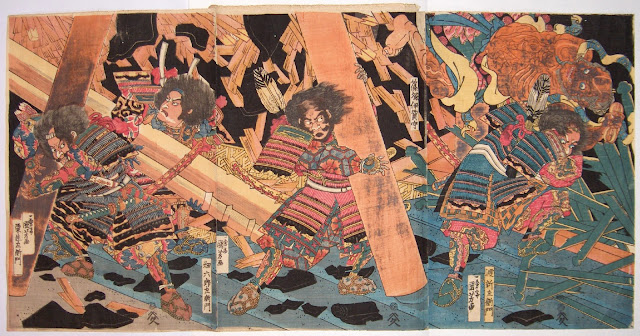Dōjō
Kelvin Grove QUT Dōjō
In Japanese, dōjō 道場 literally means "place of the way." In Japan and all over the world, a dōjō is a martial arts training hall or facility.Samurai 侍 and Bushi 武士 (Warriors) generally had training halls and facilities, but in contrast Shinobi 忍び (Ninja) and Sōhei 僧兵 (Warrior Monks) often had to train outdoors in the mountains, fields or forests.
Training outdoors in parks or natural places 自然場 (shizenjō) can be a unique challenge, but it also offers many benefits.
One benefit of training outdoors is that you get a chance to practice and hone your ukemi 受け身 (break falling). Ukemi is one of the most important skills of a martial artist and without it you will be prone to injure yourself.
Weather is another benefit of training outdoors. When training in natural conditions your body becomes used to different weather, temperatures, and humidity. There is also always fresh air and usually a breeze to cool you down.
Doujou Etiquette
Etiquette or Reihou (礼法) is an important part of martial arts practice. Reihou represent both respect and shared values, but also have practical reasons for usage.
It is customary to bow before entering a doujou and again before entering the training area. You only need to bow once at entry and when leaving, moving between the training or doujou during training does not require additional bowing.
In Japanese doujou and homes it is customary to remove the shoes at the entrance and put on slippers. It is rare for Japanese to walk barefoot or wear sandals barefoot, because it is polite to have socks on if the host doesn't have additional slippers. This is custom is primarily for hygiene purposes.
At the beginning of each class we bow in formally together facing the kamidana (神棚) which is a shinto style alter. In Honbu doujou (Headquarters), the kamidana is dedicated to Takamatsu Toshitsugu. If the doujou does not have a kamidana, the idea of showing respect to the dead and past generations is kept within the heart and mind.
At QUT Ninjutsu we usually bow in facing a tree, as QUT Ninjutsu train in a Shizenjou (natural place), we show respect both to nature and to those that came before within our hearts.
The bowing in ceremony begins by kneeling and placing the hands in Gasshou (合掌 - praying posture). The instructor or teacher will be directly behind the kamidana, while the rest of the class is lined up at a respectful distance behind the instructor. After kneeling, there is a short pause and the phrase 'Shiken Haramitsu Daikoumyo' (四拳 波羅蜜 大光明) is uttered followed by two claps of the hands. After clapping twice, the practitioner bows again, rises and claps once more, then waits. The teacher turns around and the whole class bows again uttering 'Onegaishimasu' (おねがいします).
At the end of the class the same ceremony is performed, except instead of saying 'Onegaishimasu', the class will say 'Domo arigatou gozaimashita' (どもありがとうございました).
Shiken Haramitsu Daikoumyo is a Buddhist mantra, which is roughly translated to 'May everything that I learn enlighten me'.
Onegaishimasu means 'please do for me', but a more accurate English translation in this context is 'please teach me'.
Domo arigatou gozaimashita means 'thank you very much', but in this context means 'thank you very much for teaching me'.
The bowing in ceremony can be seen in the beginning of this video:
Dōjō History
QUT Ninjutsu Dōjō started in 2008 and operated both at QUT's Kelvin Grove and Gardens Point campuses. Between 2008 and 2010 QUT Ninjutsu had approximately 500 members.
In 2010 the club was disbanded because the club captain left for Japan to study martial arts.
In 2011 QUT Ninjutsu was restarted due to popular demand.
In 2013 QUT Ninjutsu was once again disbanded because the club captain left to join the Royal Australian Navy.
In 2016 QUT Ninjutsu returned to QUT and reopened its doors.
Chauvel Place
Chauvel place is a small public park which used to stand in front of the old army barracks. In 2015, the army barracks was converted into a new creative industries precinct for QUT, but the park remained as it was Commonwealth property.
The park has ample lighting and soft grass. There are amenities near by including drinking fountains and toilets.
Instructor
Richard RothRichard started martial arts when he was 6 years old. He practiced Judo in South Africa until he was 13, then moved to Sydney, Australia. In Australia he continued to practice Judo until High School. After High School he explored many other Japanese martial arts such as Shorinji Kenpo, Iaido, Kendo, and Karate, before discovering Budo Taijutsu. In 2005 Richard joined a Bujinkan Budo Taijutsu dojo and has been training in Budo ever since. Richard first traveled to Japan in 2006 to meet Grandmaster Hatsumi Masaaki and also trained at the Bujinkan Honbu (Bujinkan Headquarters). He went back again in 2009 before deciding to live and train in Japan for a year in 2010. During his time in Japan, Richard trained both at the Bujinkan Honbu and at the Kodokan Honbu (Judo). Since 2012, Richard has continued to travel to Japan yearly to train. In 2016, he received his 5th dan in Bujinkan Budo Taijutsu and the privilege of opening his own dojo.
Richard is currently a member of Bujinkan and the Kodokan, and has 23 years experience in the martial arts as well as 4 years experience teaching the martial arts.


